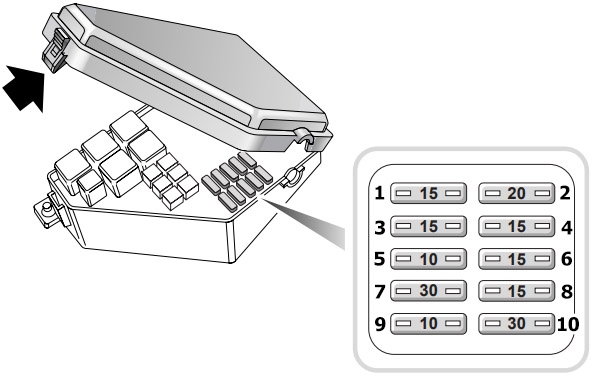Advertisements
Fuse box diagram (fuse layout), location, and assignment of fuses Rover 75 and MG ZT (1998, 1999, 2000, 2001, 2002, 2003, 2004, 2005).

Checking and Replacing Fuses
Fuses are simple circuit breakers, which protect the car’s electrical equipment by preventing the electrical circuits from being overloaded.
A blown fuse may be indicated when the item of electrical equipment it protects, stops working.
Only replace a fuse with one of the same or lower rating.
- Turn off the starter switch and all electrical equipment before changing a fuse.
- Remove the fuse box, then refer to the chart to identify the suspect fuse.
- Press the removal tweezers (located in the fuse box) onto the head of the fuse and pull to remove. A blown fuse can be recognized by a break in the wire.
- Replace a blown fuse with another of the same, or lower ratings. Note that there are a number of spare fuses located along the lower side of the fuse box.
If a replacement fuse fails almost immediately, refer the problem to your dealer or a qualified workshop as soon as possible.
Notice
- Never use a fuse of a higher or lower amperage rating than that specified. Never replace a broken fuse with anything other than a new fuse (such as wire, foil, etc). This could damage the electrical system or cause a fire.
Passenger Compartment Fuse Box
The passenger compartment fuse box is located behind the front passenger glove box. A coin or flat-bladed screwdriver is needed to remove the closure panel beneath the glove box in order to be able to access the fuse box.


| № | A | Circuit protected |
|---|---|---|
| 1 | 20 | Rear windows |
| 2 | 30 | Traction control |
| 3 | 5 | Memory seats, clock |
| 4 | 5 | Air conditioning, power windows |
| 5 | 5 | Body Control Unit, wipers |
| 6 | 5 | Instrument pack |
| 7 | 5 | Immobilisation, cruise control |
| 8 | 5 | Body Control Unit |
| 9 | 10 | Windscreen washer pump |
| 10 | 5 | Instrument pack |
| 11 | 5 | Audio system, power windows, mirrors, cigar lighter |
| 12 | 10 | Accessories socket, rear sunblind, parking aid |
| 13 | 10 | Interior lamps |
| 14 | 20 | Central door locking |
| 15 | 15 | Cigar lighter |
| 16 | 20 | Accessories socket |
| 17 | 5 | Instrument pack, engine immobilisation, ATC controls |
| 18 | 5 | Airbag SRS (yellow surround) |
| 19 | 30 | Driver’s seat |
| 20 | 20 | Fuel pump |
| 21 | 30 | Power seats |
| 22 | 15 | Audio system amplifier |
| 23 | 20 | Sunroof |
| 24 | 30 | Windows - front |
| 25 | 20 | Seat heating |
| 26 | 5 | Anti-theft alarm, engine immobilisation |
| 27 | 5 | Instrument pack |
| 28 | 15 | Horn |
| 29 | 15 | Rear wiper |
| 30 | 30 | Headlight washers |
| 31 | 15 | Alarm sounder |
| 32 | 10 | Anti-lock brakes, traction control |
| 33 | 5 | Driver’s seat belt warning, ATC controls |
| 34 | 10 | Engine management |
| 35 | 5 | Heated mirrors & washer jets |
| 36 | 5 | Alternator |
| 37 | - | Not used |
| 38 | - | Not used |
| 39 | - | Not used |
| 40 | 5 | Exterior lights |
| 41 | 10 | Cruise control, reversing lights |
| 42 | 5 | Not used |
Advertisements
Engine Compartment Fuse Box Diagram
The fuse box is located on the left-hand side of the engine compartment. Press the catch to release the hinged cover.

Owners are advised against removing or replacing the fusible links identified on the underside of the fuse box lid. Failure of any of these items should be investigated by a qualified technician.
| № | A | Circuit protected |
|---|---|---|
| 1 | 15 | Exhaust gas recirculation, injection pump, pressure regulator (diesel models) |
| Oxygen sensors (petrol models) | ||
| Engine management (all models) | ||
| 2 | 20 | Ignition coils (petrol models) |
| Engine management (all models) | ||
| 3 | 15 | Camshaft and oxygen sensors (petrol models) |
| 4 | 15 | Automatic transmission, air conditioning, cooling fan, cruise control (diesel models) |
| 5 | 10 | Engine management (petrol models) |
| 6 | 15 | Front fog lights |
| 7 | 30 | Anti-lock brakes |
| 8 | 15 | Fuel burning heater (diesel models) |
| 9 | 10 | Air conditioning |
| 10 | 30 | Wipers and washers |
Advertisements
